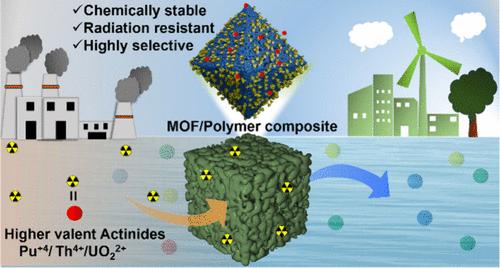化学稳健性功能化MOF/聚合物复合材料对模拟核废料中高价锕系元素的选择性隔离
IF 7
2区 材料科学
Q2 CHEMISTRY, PHYSICAL
引用次数: 0
摘要
由于全球对能源的需求不断增加,核能因其低碳排放和高能量密度输出而变得至关重要。钍和铀是核裂变工业的主要原料和能源,处置不当可能对生态系统造成严重威胁。在此,我们策略性地设计并制造了一种功能化的MOF/聚合物复合材料,通过在MIL-101的腔内原位形成交联聚合物。该多孔复合材料具有较高的化学稳定性和辐射稳定性,功能适宜,可从高酸性核废料中提取Th(IV)、Pu(IV)和U(VI)。合成的MOF/聚合物杂化吸附剂的最大吸附容量为823 mg/g和679 mg/g,在其他竞争离子存在的情况下,Th(IV)和U(VI)的分配系数(Kd)分别为2.48 × 105和1.64 × 105 mg - 1。该研究不仅显示了杂化多孔材料的巨大潜力,而且为设计功能化吸附剂提取高价锕系元素提供了基本途径,旨在实现可持续发展、无CO2能源和环境修复。本文章由计算机程序翻译,如有差异,请以英文原文为准。

Chemically Robust Functionalized MOF/Polymer Composite for Selective Sequestration of Higher-Valent Actinides from Simulated Nuclear Waste
Due to the increasing global demand for energy, the development of nuclear energy becomes crucial because of its low carbon emission and high energy density output. Thorium and uranium are the main raw materials and energy resources for nuclear fission industries, and their improper disposal may cause a serious threat to the ecosystem. Herein, we strategically designed and fabricated a functionalized MOF/polymer composite via the in situ formation of a cross-linked polymer inside the cavity of MIL-101. The porous composite with high chemical and radiation stability and suitable functionality can extract Th(IV), Pu(IV), and U(VI) from highly acidic nuclear waste. The synthesized MOF/polymer hybrid adsorbents exhibit a maximum capacity of 823 mg/g and 679 mg/g, achieving a high distribution coefficient (Kd) of 2.48 × 105 and 1.64 × 105 mLg–1 for Th(IV) and U(VI), respectively, in the presence of other competing ions. This study not only shows the great potential of hybrid porous materials but also provides a fundamental approach to designing a functionalized adsorbent for extraction of higher-valent actinides, aiming toward sustainable development, CO2 free energy, and environmental remediation.
求助全文
通过发布文献求助,成功后即可免费获取论文全文。
去求助
来源期刊

Chemistry of Materials
工程技术-材料科学:综合
CiteScore
14.10
自引率
5.80%
发文量
929
审稿时长
1.5 months
期刊介绍:
The journal Chemistry of Materials focuses on publishing original research at the intersection of materials science and chemistry. The studies published in the journal involve chemistry as a prominent component and explore topics such as the design, synthesis, characterization, processing, understanding, and application of functional or potentially functional materials. The journal covers various areas of interest, including inorganic and organic solid-state chemistry, nanomaterials, biomaterials, thin films and polymers, and composite/hybrid materials. The journal particularly seeks papers that highlight the creation or development of innovative materials with novel optical, electrical, magnetic, catalytic, or mechanical properties. It is essential that manuscripts on these topics have a primary focus on the chemistry of materials and represent a significant advancement compared to prior research. Before external reviews are sought, submitted manuscripts undergo a review process by a minimum of two editors to ensure their appropriateness for the journal and the presence of sufficient evidence of a significant advance that will be of broad interest to the materials chemistry community.
 求助内容:
求助内容: 应助结果提醒方式:
应助结果提醒方式:


